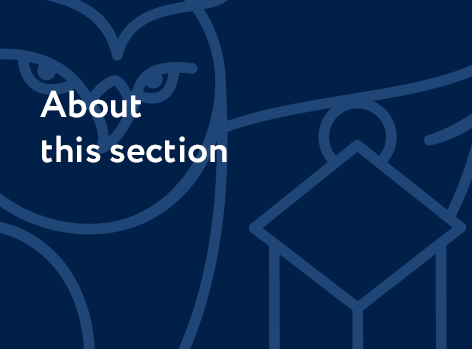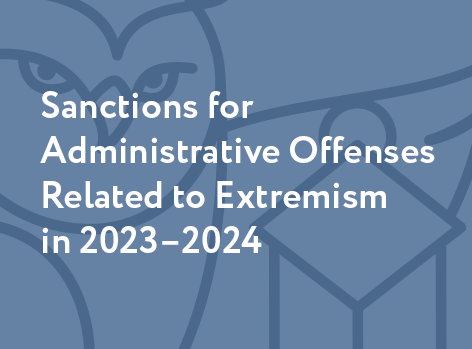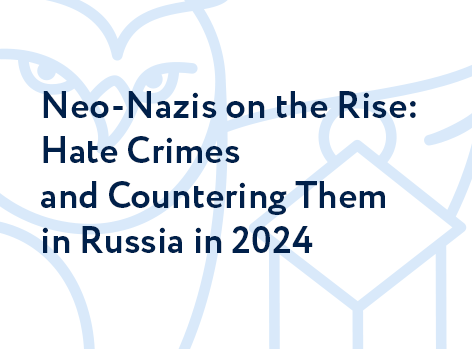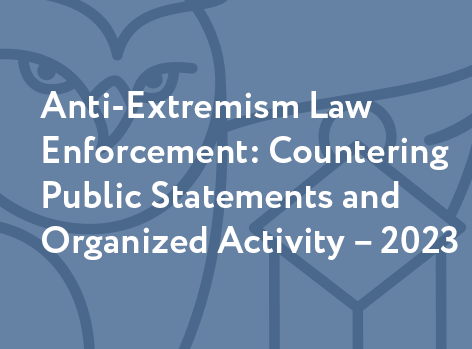The Metamorphoses of Post-Soviet Russian Nationalism: Less Violence, More Bonds. Resentment Is Inevitable.
Alexander Verkhovsky on Russian nationalism: Who Are You? Russians? [Novaya gazeta]
Russian nationalism has been one of the most discussed types of worldviews and political orientations in Russia for nearly 40 years, beginning with the Gorbachev perestroika. This is not a unitary movement. Russian nationalism is extremely heterogeneous in both time and the political dimension of these four decades. Therefore there is no consensus on which figures and associations should and should not be ascribed to Russian nationalism. There are major disagreements about how significant Russian nationalism has been for Russian politics and society in one period or another.
Largely, the problem is that neither scholarship nor everyday language has a generally accepted definition of nationalism. And there are always disagreements regarding the attribution of given views to Russian nationalism. Nonetheless, we can, by resting on the ideas of figures and organizations considered to be representatives of this movement almost by consensus, compose an idea of Russian nationalism. And then to understand how it has changed, what its boundaries have been at different times, and what place Russian nationalism has occupied and does occupy in our society.
There are numerous trends, both ideological and political, that their participants and/or observers have considered nationalistic. These trends, unlike others, pay more attention to “nationalistic” themes. This, I think, is the most effective way to distinguish the various ideological types of political associations: to see which elements of the political agenda possess relatively more significance for them.
If an association or an author is most concerned with the ethno-cultural identity of society and the state, its boundaries and sovereignty, its language policy, the historical pride of the nation, and the defense of its traditions, then the object of its interests allows us to categorize this association or author as nationalistic. This does not mean that they have no other interests or that other associations or authors are completely indifferent to elements of the nationalistic agenda.
Nationalists can have various views regarding various elements of this agenda. For example, they do not have a shared notion of who Russians are.
Late-Soviet Russian nationalism, which existed both in the establishment and in grassroots, even dissident activism, emerged on the political stage in 1987, when Dmitry Vasiliev’s Pamyat organized a march in Moscow from Manezhnaya Square to the Moscow Municipal Council buildings and secure a meeting with Boris Yeltsin, the head of the CPSU’s municipal committee.
Almost immediately after this, a schism occurred in Pamyat into the “reds,” who tried to combine ideological loyalty to both the Soviet and pre-Soviet legacy, and the “whites,” who clearly preferred the latter to the former. For the perestroika period, this was a fundamental distinction. Later it was reproduced multiple times in other organizations as well. The opposition to the Gorbachev and later the Yeltsin course lined up primarily starting from pro-Soviet positions. Later, for many years, the nationalists who took part in this opposition had to decide for themselves between the “red” and “white” orientation or a reconciliation of the two, and they did so in various ways.
Organizationally, the history of Russian nationalism over the five or six years after the march to the Moscow Municipal Council turned primarily around three topics. First, the endless schisms in the organizations that were part of Vasiliev’s Pamyat along with the simultaneous growth in their total numbers. Second, the attempts at self-organization by Soviet-era nationalists close to the establishment. At first, these were primarily cultural figures who grouped, as per Soviet tradition, around literary journals (certain “village prose” writers, Aleksandr Prokhanov, Valery Ganichev, and so on), and later they were joined by highly placed Soviet bureaucrats of various types (Gennady Zyuganov, Petr Romanov, and so on). Third, the building and destruction of opposition coalitions of “reds” and “whites” that would take too long to list. The apotheosis of this process was the creation of the National Salvation Front in 1992.
Two basic trends dominated ideologically: the “white” addressed itself to “the Russia we lost,” the empire of the Romanovs; the “red” to the Soviet Union at its imperial height, that is, the Stalin era.
The latter trend clearly surpassed the former both in opposition coalitions and (at least beginning in late 1991) in mass moods (judging from VTsIOM [All-Russian Center for the Study of Public Opinion] surveys at the time).
With the potential and then the real collapse of the Soviet Union, nationalism became primarily nostalgic in nature. In addition to these two variations on the “golden age” to which we should return, there were also others less popular. For some nationalists, even Russia of the prerevolutionary decades and centuries was too pro-Western. And so they wished to return to “Holy Rus,” an idealized image of the Muscovite kingdom. An even more radical version proposed its roots in Rus’s adoption of Christianity. So that the “golden age” was to be sought in mythological Slavonic heathen antiquity.
Since the Soviet era, there have also been nationalists who found the “golden age” not in the Russian past but nearer to hand—in the ideas of European fascism and national socialism. There were few true heirs of Mussolini or Hitler among them. More often, it was a matter of confirming radical nationalistic views of Russia’s development by appealing to those authorities (sometimes simply using stylistic gestures). At the same time, in the late 1980s and early 1990s the idea of a “third way” (neither socialist nor capitalist) important for the fascist tradition enjoyed fairly broad popularity by no means only among those who considered themselves fascists, inasmuch as it was at that time that the country was transitioning from the socialist to the capitalist vector of development. In this sense, “Russian fascism” was the product of nostalgia and the choice of utopianism as alternatives to reality.
But a consistent choice of ideological orientation was not the lot of many. The views of nationalists beginning with Pamyat were dominated by eclecticism. Thus, obviously eclectic were the views of the most long-lived party among moderate nationalists: Sergei Baburin’s Russian All-People’s Union (ROS). The most famous nationalistic organization of the 1990s—Aleksandr Barkashov’s Russian National Unity (RNE)—only seemed fascist. Its ideological notions were quite impoverished and very heterogeneous. And beginning in the early 1990s, the star rose of post-Soviet Russia’s chief political eclectic—Vladimir Zhirinovsky.
One way or another, the political organizations of nationalists of 1990s perestroika were looking backward—to the past of Russia, Germany, and so on.
The one exception may have been the National Bolshevik Party (NBP) of Eduard Limonov and Aleksandr Dugin, which fancifully and erraticly combined the most varied “anti-systemic” views without basing itself on any “golden age” in the past.
But the National Bolsheviks remained an exception that did not give birth to any actual trend.
Organizations of Russian nationalists were on the rise until about 1995. Properly nationalistic blocs, starting with the LDPR [Russian Liberal Democratic Party], were able at the time to garner about 17% of the votes in parliamentary elections, while the partially nationalistic Russian Communist Party and KRO [Congress of Russian Communities] won about 43.5% (noticeably better than their total of 35% in 1993). In the latter half of the 1990s, their activeness and electoral results were on a steady decline. In the 1999 Duma elections, the nationalists won 8%, and together with the partially nationalistic parties 32%.
Evidently, toward the late 1990s, nostalgia for the collapsed Soviet Union as the prime mover of the Russian nationalism of the day had ceased to function as a factor of political mobilization. Although, of course, this nostalgia never did run out of steam, and later it was utilized successfully by the most varied political forces. Also of significance was the fact that ethnic xenophobia, which, according to VTsIOM calculations increased gradually from the late 1980s through the mid-1990s, later began to decline and only at the end of that decade started rising once again.
And what about the regime, the ruling portion of the political class? Throughout the post-Soviet years of the last century they were surprisingly little concerned with any issues whatsoever of the nationalist agenda.
Some ruling groups might have allowed and even nourished xenophobic prejudices, as happened with respect to the Chechens even before the first Chechen war. They might have intervened in conflicts in former Soviet republics. But at the same time the Russian authorities did not pursue any nationalistic goals. To a certain extent one could probably consider as a nationalistic goal keeping the country from breaking up, which, evidently, was the chief motive for the start of the first Chechen war. Only toward the end of the decade, through the efforts of Evgeny Primakov, did another nationalistic theme become relevant: the defense of Russia’s sovereignty and sphere of influence in the confrontation with the West.
Meanwhile, during the latter half of the 1990s, a new and youthful outgrowth of Russian nationalists multiplied frighteningly: Nazi skinheads. They were extremely anarchical, took almost no part in politics, and on the whole were very skeptical toward the “old nationalists”. They gave birth to a tremendous wave of street violence, making it a real strategy that was supposed to revolutionize the masses in its struggle against ethnic and political enemies. They differed radically from their predecessors in that they were Russian nationalists only secondarily (and some weren’t that at all). Above all, the skinheads were white racists. This defined their attitude toward nearly all items on the nationalistic agenda. For example, they cared little about the borders of the empire that Russia inherited. They would have preferred borders that facilitated racial purity.
It is believed that in the early 2000s, the numbers of this movement reached approximately 50,000, although, of course, the active core was much smaller. Absent an open and broad public polemic between the “old” and “new” nationalists, it is impossible to say how mass support might have been been divided between them. Evidently, the majority of citizens substantially concerned with elements of the nationalistic agenda simply could not navigate the ideological disagreements among nationalists and did not give them much thought.
It was on the skinhead activist base, now a little more mature, that the main nationalistic movement of the 2000s arose: Aleksandr Belov’s Movement Against Illegal Immigration (DPNI). The DPNI was blatantly racist but at the same time tried to be populist, following as much as it could a few Western European models (at the time, the most famous in Russia being the French National Front and the Freedom Party of Austria). This forced it to reject the dogma of white racism at least in part, while at the same time maintaining its penchant for everyday racism, which was quite widespread in post-Soviet societies.
Most important, though, the DPNI no longer sought a “golden age” in the country’s past. It offered its own project for the future, “Russia for Russians,” that is, a society ethnically homogenized to a certain extent in which ethnic Russians would enjoy a privileged position. Other characteristics of the social structure were of very little concern to the DPNI, unlike organizations of the 1990s.
The new wave of Russian nationalists sought emotional support not in a weakened imperial resentment (although that has yet to vanish) but specifically in xenophobia and migrant-phobia.
They had grounds for counting on success. It was in the early 2000s that the level of xenophobia in society increased markedly and barely declined afterward. Nearly half of citizens gave positive answers to several security questions (about the desirability of discrimination against migrants, and so on), and in the capital it was even more. From that moment to this day, xenophobia and concern over the “migrant threat” remain Russian nationalism’s main themes.
The DPNI has not been the only one. For decades, blatantly neo-Nazi organizations have either collaborated or competed with it: the Slavic Union, the National Socialist Society, Russky Obraz, and many autonomous neo-Nazi groups oriented primarily toward violence that have been preserved.
“Systemic” nationalists have continued to act, too: Dmitry Rogozin’s Rodina party and the LDPR and Russian Communist Party, which have episodically turned to a nationalistic theme, as well as various groups of intellectual nationalists, from the old circle around Zavtra newspaper to Konstantin Krylov and Egor Kholmogorov. These groups and movements grew and became more noticeable—perhaps not in elections, which were already strictly “regulated,” but on the level of “street politics.” By the late 2000s, the nationalists had overtaken not only the liberal opposition but also the Russian Communist Party in this theme.
The regime used various methods to limit and at least in part suppress oppositionist nationalistic activism. They took this up in earnest after the riots in Kondopog in fall 2006, focusing on groups practicing racist violence and terror. And after a few years they had had quite a lot of success at it. Beginning in the early 2010s, the regime moved from routing militant groups to banning political ones, in an attempt to marginalize ethnonationalism in Russian political life.
Simultaneously, on the foreign policy agenda, the regime increasingly developed the course it had chosen in 1999 toward confronting the West. In 2003, in domestic policy, permission was given to create the Rodina bloc for the sake of weakening the Russian Communist Party, and in the late 2000s, attempts were made to manipulate nationalistic groups. In those years, this was called “controlled nationalism”: the regime supported certain ultra-rightist organizations to counterbalance others (primarily Russky Obraz against the DPNI) and ordered pro-Kremlin “youth groups” to use elements of ultra-rightist rhetoric in a moderate form.
But this was merely a tactical ploy. Beginning in the early 2000s, authoritarian tendencies began to mount in domestic policy, but the authorities rarely took the nationalistic agenda seriously. This changed after the ultra-rightist riots on Manezhnaya Square in Moscow in December 2010, when a unique situation came about: the police were unable to cope with the several thousand football fans and ultra-rightists, moreover right outside the Kremlin walls.
The regime reacted to the riots with speeches and official documents that in the years 2011-2013 shaped the “official version” of Russian nationalism (later, in 2020 and 2022, changes in it were noted).
Official nationalism emphasizes the political unity of the Russian nation, contrasting it to ethnic—including Russian—nationalisms. This ideological program asserts the priority of political loyalty over ethnic and religious loyalty.
In this ideology, the basis for a common identity is conceived of as the restoration of the empire’s grandeur (although the word “empire” is not used in this), which is defending itself against a significant and mighty Other: the West. The empire cultivates ethnocultural diversity but asserts the notion of its ethnocultural core—Russian and Orthodox. Therefore, the theme of preserving the sphere of influence inherited from the Soviet Union is understood not only in the geopolitical sense but also in the sense of ethnocultural affinity.
The empire does not define itself through a global ideological project, as the Soviet Union once did. Nonetheless, it does have such a project: it is positioning itself as the global leader in the defense of “traditional values.” Mikhail Suslov, author of a recently published book about the Putin ideology, does not consider this nationalism. But this project focuses on elements of the nationalistic agenda, and lately this focus has only intensified. So I think that it is more correct still to consider contemporary Russian official ideology to be a special version of nationalism that the regime has advanced largely as an alternative to the ideas of Russian ethnonationalists.
In the Russian nationalists’ movement, such as it was in the early 2010s, still strong then was the component of white racism, which was not that popular in Russia, and the quite unpopular attachment to its neo-Nazi roots. When the nationalist movement in that form tried to participate in the 2012 protests, it led only to internal crisis. Later, in early 2014, there was a large-scale and as yet unresolved schism in the movement over the “Ukrainian question.” The movement’s further swift degradation was aided even more by domestic problems than by ideological competition or repression on the part of the regime.
It is interesting that the schism over the “Ukrainian question” both then and now was not predetermined by how individual groups or authors understood Ukrainians—as a part of the Russian people, as a part of some triune community, or as a separate people. The explanations for why a given nationalist took or refused to take one side or another in the conflict vary greatly. But it must be noted that the pro-Kyiv Russian nationalists were dominated by those who were closer to white racism and among the pro-Donetsk ones by those who for all their ethnonationalism felt more affinity for the themes of the state’s greatness and its confrontation with the West.
Of course, this brought the pro-Donetsk ones closer to the official course. But one should not think that this ruled out their oppositional nature: the relationship between various groups of nationalists and the authorities did not evolve easily. And even among nationalists, the attitude toward authoritarian rule as such, whether positive or negative, changed over the years and did not correlate very well with their positions on the “Ukrainian question.”
By 2020, the racist pro-Kyiv wing of Russian nationalism as a whole was much weaker than the pro-Donetsk and pro-regime ones. Although the latter did weaken significantly, losing out to state propaganda. In practice this meant that oppositionist Russian nationalism such as we knew it in the 2000s had exhausted itself.
By the way, in the context of the conflict in the Donbas, even the level of ethnic xenophobia in the country declined steadily for several years. By the time it returned to its former level in the late 2010s, politically organized oppositionist nationalism had nearly disappeared.
What could take the place of 2000s-style nationalism under the pressure of an increasingly repressive and increasingly ideologized state power?
Back at the turn of the 2010s, Russian nationalism’s self-definition was starting to move toward national democracy and, on the whole, to a more civic rather than ethnic or imperial nationalism. This was evident not only in Aleksei Navalny’s activities at the time and not only in nationalists’ participation in the 2011-2012 protests. But this move never did happen, and the “national democrats” remained only small groups.
On the other hand, there was no even slightly independent movement oriented on the whole toward the Kremlin’s described ideological priorities either: the authorities were obviously not interested in self-organization from below in support of official policy. The attempts observed starting in 2019 to revive the nationalistic movement, for instance, through the efforts of Konstantin Malofeev, clearly had no chance of success.
Beginning in 2022, the situation of large-scale armed conflict created a need in the regime for ideologically motivated support from below. It did not necessarily have to be nationalistic primarily, but that, too, was helpful. And what is no less important, the theme of the “migrant threat” became more acute once again in parallel to and independently of the “Ukrainian question.” Since then, it has only developed more and more powerfully.
Together, these two factors—the regime’s desire to obtain support from below and the anti-migrant moods inspired by propaganda—launched a process of change in the ideological and propagandistic complex that could be called official nationalism. For now, though, this process is far not only from completion but also, apparently, from a decisive turn.
Simultaneously, these same two factors and the ideological changes that had begun at the top created favorable soil for a new rise in nationalism from below. It has been unfolding in a substantially more authoritarian regime than in the 2010s and especially the 2000s, to say nothing of the 1990s. Therefore, enjoying increased demand for nationalism may be primarily groups that do not diverge too much from the authorities and do not attempt to enter into political competition with them. In this, the “critique of individual shortcomings” on the part of those groups is quite tolerable. Therefore, lately, there have arisen associations like the Russkaya Obshchina made up of a network of local groups active in three spheres at once: confrontation with migrants, defense of “traditional values”, and support for the SVO [special military operation].
So far, this dynamic has not yielded sufficient grounds for imagining what Russian nationalism—both state and grassroots—will be like in a few years. The main uncertainty is how quickly a “return of politics” will come about in Russia in whatever form. If this happens in the not-too-distant future, then present-day Russian nationalists will have a few more chances of mobilizing support than did the nationalists of the 2000s.
Compared with the DPNI and similar forces, we see in the present movement less revolutionarinesss, less criminal violence, a more balanced thematic (in particular, less white racism), and more defense of customs (for example, against immigrants and “gay propaganda”). Finally, present-day support for the SVO is being converted into an affinity for inevitable mass postwar resentment. But since the movement is developing in the shadow of “official nationalism,” a lot depends on what form the latter will be taking by then.
Translated by Marian Schwartz




